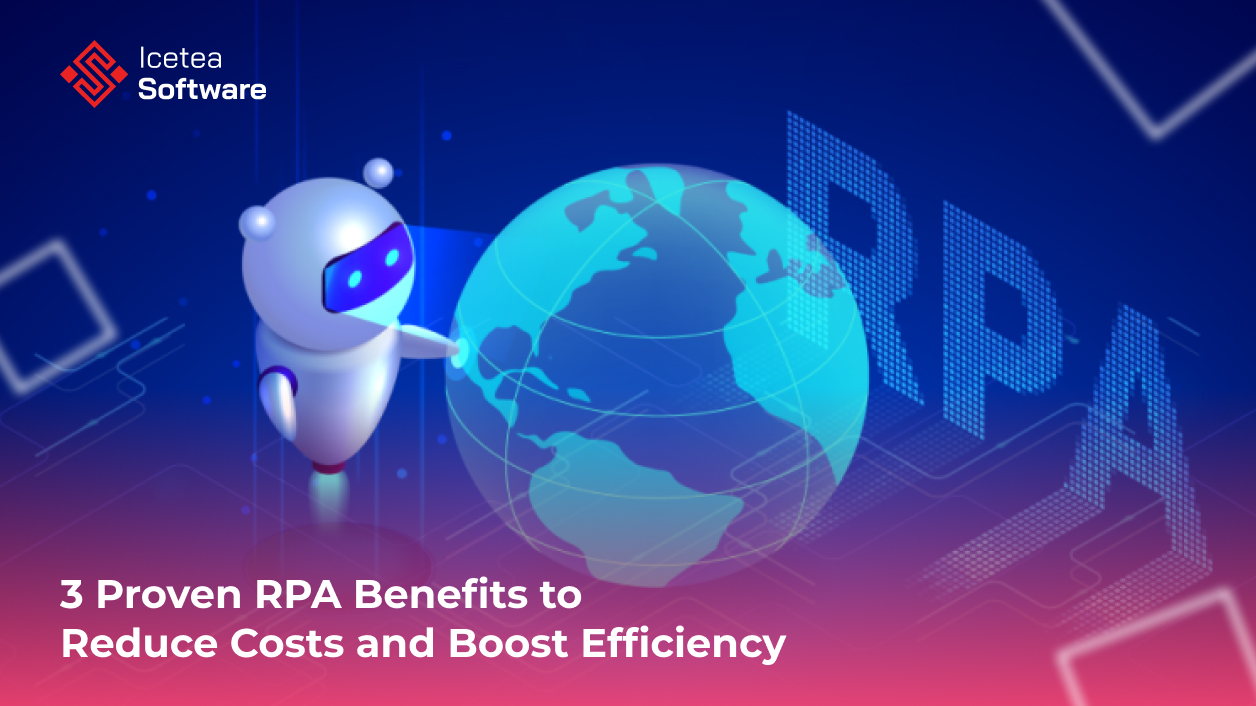3 Proven RPA Benefits to Reduce Costs and Boost Efficiency

Robotic Process Automation (RPA) is no longer just a back-office tool—it has become a powerful driver of operational efficiency and cost optimization across industries. By automating repetitive, rule-based tasks, businesses can free up employees for higher-value work, minimize errors, and deliver faster results.
In 2025, as enterprises face rising competition, tighter budgets, and increasing pressure to scale, RPA is emerging as a cornerstone technology for sustainable growth. This blog explores three essential ways RPA optimizes costs and operations, along with practical examples, benefits, and best practices to help organizations maximize their return on automation.
1. RPA Reduces Operational Costs Through Automation Efficiency
Eliminating Manual, Repetitive Tasks
One of the biggest expenses in any organization is labor. Employees spend hours each day performing repetitive tasks such as:
- Data entry into multiple systems
- Invoice processing
- Payroll preparation
- Report generation
These tasks, while necessary, consume significant resources without contributing to innovation. RPA bots can handle them with speed and accuracy, operating 24/7 without fatigue.
For example, in finance departments, RPA can reduce the time to process an invoice from 10 minutes manually to under 2 minutes with automation. When scaled across thousands of invoices, the savings are dramatic.
Cost Savings Through Error Reduction
Manual processes are prone to mistakes, which can lead to financial losses, compliance penalties, and customer dissatisfaction. Each error carries a cost—whether it’s correcting wrong entries, refunding customers, or resolving regulatory fines.
RPA reduces error rates by following pre-defined rules with precision. This minimizes rework, eliminates duplicate efforts, and prevents costly mistakes.
Lowering Overhead and Outsourcing Costs
Traditionally, companies outsourced repetitive tasks to reduce labor costs. But outsourcing introduces new expenses such as vendor contracts, data security risks, and management overhead. RPA allows businesses to automate in-house, cutting outsourcing costs while maintaining control and compliance.
Key Cost Benefits:
- Reduced full-time equivalent (FTE) workload
- Elimination of outsourcing contracts for repetitive tasks
- Decreased error correction costs
- Improved compliance and audit readiness
2. RPA Improves Operational Agility and Productivity
Faster Turnaround Times
In a fast-paced business landscape, speed is critical. Customers expect real-time responses, and organizations must process data faster to stay competitive. RPA bots can perform tasks in seconds that take humans hours.
For example, in customer service:
- Bots can instantly extract customer data from multiple databases
- Automatically generate personalized responses
- Trigger service requests without human intervention
This leads to faster resolution times and improved customer satisfaction.
Scaling Operations Without Additional Headcount
As companies grow, operations scale in complexity. Traditionally, scaling meant hiring more staff. With RPA, businesses can handle higher workloads without increasing headcount. Bots can be deployed and scaled quickly across departments, ensuring seamless growth without ballooning costs.
For instance, during peak seasons, retail companies often face surges in order processing and customer inquiries. Instead of hiring temporary staff, RPA bots can be activated to handle spikes in demand, ensuring smooth operations.
Enabling Employees to Focus on Value-Added Work
Perhaps one of the most underestimated benefits of RPA is the human factor. By taking over mundane tasks, RPA frees employees to focus on:
- Strategy and decision-making
- Innovation and product development
- Customer engagement and relationship-building
This not only boosts productivity but also increases employee satisfaction and reduces turnover—another hidden cost many companies overlook.
Key Productivity Benefits:
- Faster customer response times
- Increased capacity without added workforce costs
- Better employee morale and retention
- Enhanced scalability and flexibility
3. RPA Drives Long-Term Strategic Value and ROI
Strengthening Compliance and Risk Management
Regulatory compliance is costly. Errors in reporting, tax filings, or data handling can result in heavy penalties. RPA provides an auditable trail of actions, ensuring every process is transparent and compliant.
For example:
- In banking, RPA can monitor transactions for fraud detection
- In healthcare, bots ensure patient data is processed in compliance with HIPAA and GDPR
- In manufacturing, automation ensures accurate reporting for quality control
By reducing compliance risks, businesses save money on fines and maintain trust with stakeholders.
Data-Driven Insights for Continuous Optimization
Beyond execution, RPA can capture valuable operational data. By analyzing process performance, businesses can identify inefficiencies and make informed decisions.
For instance, RPA analytics can reveal:
- Which processes are bottlenecks
- Which tasks consume the most resources
- How performance improves post-automation
This data empowers leaders to refine workflows, optimize costs further, and continuously improve operations.
Sustainable ROI Over Time
While RPA implementation requires an initial investment, the returns are substantial and measurable. Organizations often achieve payback within 6–12 months of deployment.
According to Deloitte, companies that scale RPA effectively can realize cost reductions of 30% to 60% while significantly improving productivity.
Key Strategic Benefits:
- Reduced compliance risks and penalties
- Data insights for ongoing optimization
- Sustainable ROI with quick payback periods
- Competitive advantage through operational excellence
Case Studies: RPA in Action
Finance and Accounting
A global logistics company automated its accounts payable process. RPA bots processed invoices automatically, cutting processing time by 70% and reducing errors by 90%. The result was an annual savings of over $500,000.
Healthcare
A hospital system used RPA to handle patient data entry and insurance claims. This not only reduced claim processing times by 60% but also improved patient satisfaction by eliminating billing errors.
Retail
A large e-commerce brand implemented RPA to manage order tracking and customer emails. Bots responded to inquiries instantly, improving customer experience while saving the equivalent of 50 full-time staff costs annually.
Best Practices for Implementing RPA Successfully
- Identify High-Impact Processes First
Start with repetitive, rule-based, and high-volume processes for maximum ROI. - Involve Stakeholders Early
Collaboration between IT and business units ensures smooth adoption and alignment with business goals. - Start Small, Then Scale
Begin with a pilot project, measure results, and expand gradually to avoid disruption. - Ensure Governance and Security
Define clear policies for bot management, compliance, and data privacy. - Combine RPA with AI
For advanced capabilities, integrate RPA with AI and machine learning. This allows automation of not just rules-based tasks but also cognitive tasks such as document understanding and sentiment analysis.
Final Thoughts
RPA is more than just a tool for automating tasks—it’s a strategic enabler for cost reduction, operational efficiency, and long-term value creation. By reducing manual work, improving agility, and driving sustainable ROI, RPA empowers businesses to thrive in an increasingly competitive market.
The three essential ways RPA optimizes costs and operations—efficiency, productivity, and strategic value—make it a must-have in every digital transformation roadmap. Organizations that embrace RPA today will not only save costs but also gain a future-ready workforce and a competitive edge.
As we move deeper into 2025, companies must look beyond traditional cost-cutting measures and embrace automation as a core driver of business success.
About Icetea Software
Icetea Software is a Vietnam-based technology firm specializing in scalable, secure, and future-ready solutions in Web3, AI, and digital transformation. With operations in Vietnam and Korea, the company supports global enterprises and startups through end-to-end technology services, infrastructure development, and innovation consulting.
𝗜𝗰𝗲𝘁𝗲𝗮 𝗦𝗼𝗳𝘁𝘄𝗮𝗿𝗲 – Revolutionize Your Tech Journey!
Website: iceteasoftware.com
LinkedIn: linkedin.com/company/iceteasoftware
Facebook: Icetea Software
X: x.com/Icetea_software







